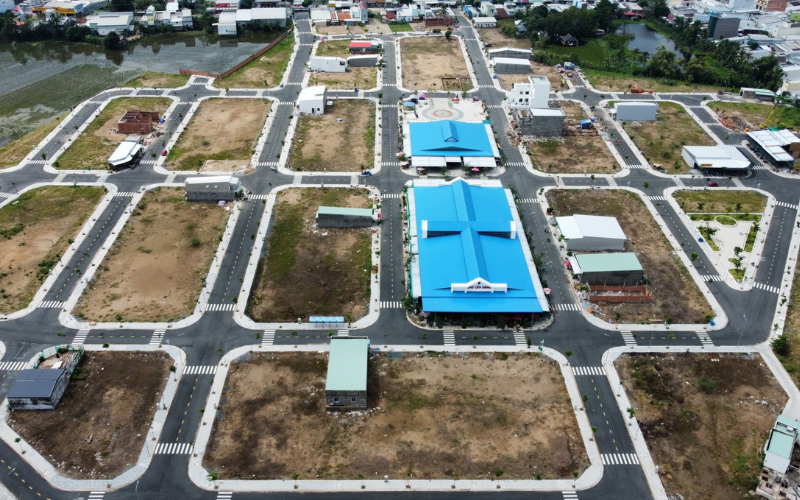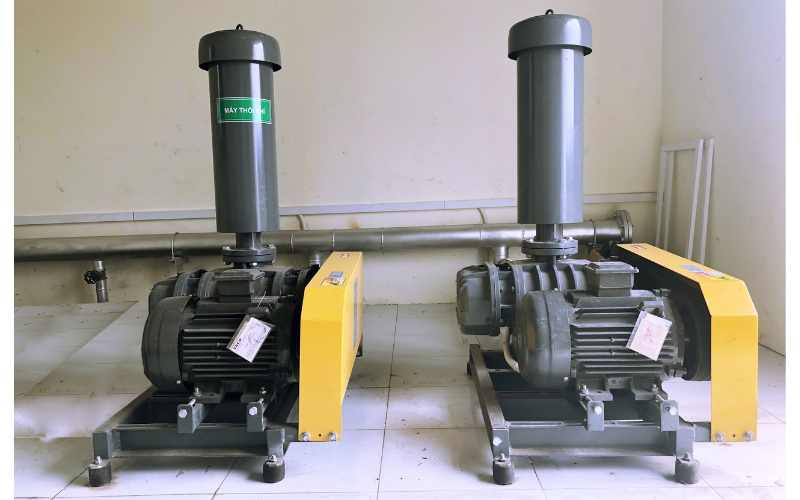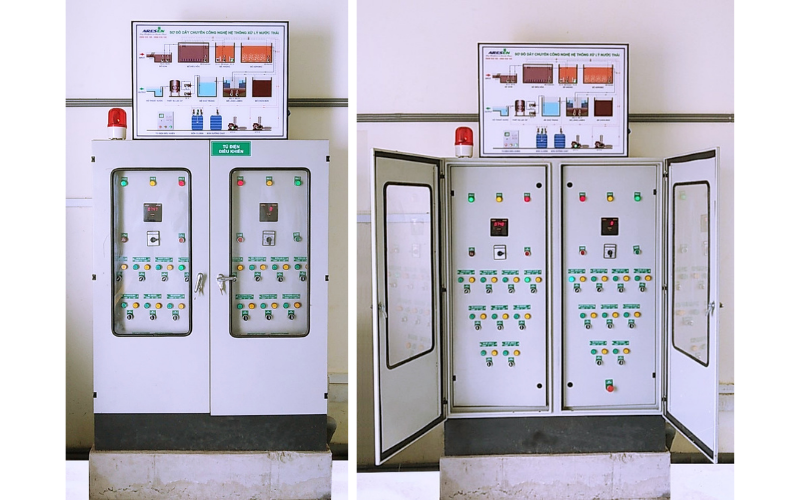In recent years, Vietnam has been evaluated as one of the countries with a rapid urbanization rate. However, the investment in the technical system of urban infrastructure in general and the urban water supply and drainage system in particular in our country is still limited.
The rapid urbanization process leads to the formation of large residential areas and urban areas. Consequently, it will cause serious environmental impacts, a large amount of wastewater and domestic waste are discharged directly into the environment, lead to contamination of both surface water sources and underground water sources, affecting the quality of human life. So how to solve the above problem thoroughly, to protect a safe – clean living environment for the residential community?

Origin of domestic wastewater in urban areas and commercial centers
Domestic wastewater is usually discharged from apartments, offices, schools, hospitals, markets, other public works in residential areas and commercial centers. Domestic wastewater includes two types:
- Water contaminated by human excreta from restrooms.
- Wastewater is contaminated by domestic wastes: residues from the kitchen, washes from house cleaning, etc.
Characteristics and composition of domestic wastewater in urban areas and commercial centers
The typical composition of domestic wastewater depends on the emission source, mainly the following criteria: BOD5, COD, SS (suspended residue), nutrients (N, P), surfactants ( mineral oil) and Coliform, etc.
- Indicators of BOD5, COD, SS: due to organic substances contained in wastewater including compounds such as proteins (40 – 50%); Carbohydrates (40 – 50%) arise from waste products in feces, in food leftovers, etc.
- N, P criteria: present in the components Protein (food), amino (urine), Phosphorus (faeces), …
- Surfactants (mineral grease): arising from laundry soap, dishwashing liquid, shower gel, etc.

Diagram of domestic wastewater treatment in urban areas and commercial centers

Explanation of the diagram of domestic wastewater treatment in urban areas and commercial centers
- Collection tank: Concentrated wastewater generated from the toilet is collected to the organic waste decomposition tank, where anaerobic decomposition will take place to reduce the concentration of pollutants and the water after the septic tank will automatically flow to the equalization tank of the wastewater treatment system. The water after the septic tank will automatically flow to the conditioning tank of the wastewater treatment system. Because domestic wastewater often contains a high content of grease, the grease trap device is responsible for keeping the grease in the tank before it enters the treatment system, in order to reduce the possibility of clogging of the pump, pipeline & reduce the biological processing behind. Waste water from the grease separation tank is directed to the equalization tank of the wastewater treatment system.
- Equalization tank: The generated domestic wastewater is collected along the wastewater collection pipeline and brought to the equalization tank. The equalization tank is designed in an anaerobic form in combination with sludge decomposition, in order to decompose organic solids in wastewater from the toilet. At the same time, in this tank, a return pipe is arranged from the high-load sedimentation tank, in order to reduce the residual sludge in the biological treatment tank and dilute the pollution concentration of the newly received wastewater stream. From here the wastewater flows by itself into the sludge fermentation tank. Waste water entering the tank is distributed according to the area of the bottom of the tank. Water flows from the bottom to the top. Organic matter dissolved in wastewater is absorbed and decomposed by microorganisms. The main task of the tank is to decompose phosphorus, create an anaerobic environment for sludge and activate beneficial microorganisms for the following metabolic processes.
- Anoxic tank: In the Anoxic tank, NO3- in the wastewater generated from ammonium oxidation in the aerobic tank, is pumped and circulated to the Anoxic tank, along with activated sludge and charged wastewater with oxygen deficiency, NO3 reduction process – to N2 is freely displayed. Total nitrogen content in wastewater is reduced to the allowable level. The process of converting organic nitrogen in wastewater in the form of ammonium to free nitrogen is carried out in two steps involving two autotrophic microorganisms, Nitrosomonas and Nitrobacter.
- Aerobic tank: The anoxic bioreactor combined with the aerobic bioreactor is an upgraded version of the classic activated sludge system specifically designed to remove both organics and nitrogenous compounds (in the form of ammonium and organic nitrogen). Oxygen (air) is supplied to the aerobic tank by airblowers and a highly efficient air distribution system with a bubble size of less than 10 µm. The amount of dissolved oxygen in wastewater at the Aerobic tank is always maintained in the range of 2-3 mg/l to ensure adequate oxygen supply for living organisms and to consume organic matter in wastewater. The amount of gas supplied to the tank for the purposes of: (1) providing oxygen for aerobic microorganisms to convert dissolved organic matter into water and carbon dioxide, organic nitrogen and ammonia into NO3- nitrate, (2) mixing evenly wastewater and activated sludge create favorable conditions for microorganisms to have good contact with the substrates to be treated, (3) release gases that inhibit microbial life, these gases are generated during the process that microorganisms decompose pollutants, (4) positively affect the reproduction process of microorganisms. The organic matter load of the tank during the aerotank treatment phase ranges from 0.32 to 0.64 kgBOD/m3.day and night.
- Sedimentation tank: The water after the aeration tank will be led through the sedimentation tank. The sedimentation tank is responsible for settling and separating the activated sludge from the wastewater. Part of the sludge will be pumped and circulated back to anoxic tank, aerobic tank to to denitrify and reduce sludge biomass while enhancing the ability of microorganisms to decompose organic matter. The rest will be taken to the sludge storage tank. The sedimentation tank is designed to remove the solids in the form of suspension, remove the odor of the wastewater to improve the sedimentation efficiency of the residues in the wastewater.
- Disinfection tank: Wastewater after removing all the activated sludge suspended in the wastewater at the sedimentation tank will be passed through a contact tank that is disinfected with chlorine chemicals to remove bacteria. The water after being disinfected meets the discharge standards QCVN 14:2008/BTNMT, column A and is discharged to the receiving source.
- Sludge storage tank: After a period of operation, residual sludge will be generated. Excess sludge from the treatment compartments is collected in the sedimentation tank. A part will be recirculated to the anoxic tank to provide microorganisms for biochemical process, the rest will be taken to the sludge storage tank. The sludge in the sludge storage tank after a period of operation will be full, at this time it must be sucked out and treated properly.
Domestic wastewater treatment system in urban areas and commercial centers consulted, designed and constructed by ARES Environment


With many years of experience and owning a team of technical experts, ARES Environment has consulted, designed and constructed many domestic wastewater treatment systems reaching standard in urban areas and commercial centers with minimum cost for many businesses in An Giang province and other provinces.
Please contact us immediately to consult the most specialized solution for you: Hotline 0909 939 108








